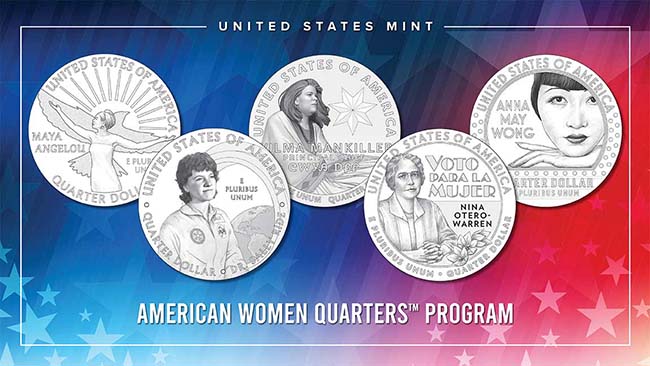
Image Source: U.S. Mint Twitter Account
How often do you consider the faces appearing on U.S. currency? The default faces on coins and bills have historically been men—presidents and significant historical figures—while only a few women have been featured along the way. Most of us have encountered the striking gold Sacagawea golden dollar coin and perhaps the Susan B. Anthony dollar, which was the first U.S. coin to feature a woman.1 Pocahontas was the first woman featured on a U.S. bill and Martha Washington is the only other to be featured on government-official paper bills.2 While there is much hope and news about Harriet Tubman becoming the new face of the $20 bill, we still have several years to wait before that historic change takes place.3
A new program developed by the U.S. Mint is taking the opportunity to feature more women on our currency. The American Women Quarters™ Program will celebrate the significant contributions of Maya Angelou, Dr. Sally Ride, Wilma Mankiller, Nina Otero-Warren, and Anna May Wong. I am thrilled to see such a diverse group of women—from different eras and such strikingly different sectors of influence (ranging from poetry to space travel to politics to Hollywood)—receiving long overdue and well-deserved representation. And yet, I would be remiss not to recognize the ways in which we can still improve and reflect on the historical shortcomings that make this project so exciting.
I cannot see these coins, and the slow progress toward a bill featuring Harriet Tubman, without acknowledging that the exclusion of women from the U.S. presidency brought us here. I cannot ignore the fact that nearly all the coins and bills that include women have merely been special editions and not a full replacement of the predominantly white male representation we have had throughout history on our currency and in positions of power. And further, I also cannot unsee the many additional barriers women of color, trans women, and so many others facing institutional injustice must face every day in our nation. Where is representation that recognizes intersectionality? Where is the nuance in understanding that while representing every individual person is likely impossible, we can have conversations that resonate deeply and evolve to include more as we learn more?
While the power of developments in representation should not be understated, I believe it is vital to take that empowerment and push for more. Our very definition of womanhood is growing and changing as we unlearn norms, stereotypes, gender roles, and even the gender binary itself. I look forward to seeing the faces of these courageous, inspiring women on our U.S. quarters, and I also look forward to a time when diverse representation (across all mediums) is nothing new.
Sources
Do you have a story idea for us? Do you want to submit a guest blog? If it's about equity, diversity, or inclusion, please submit to edi.stories@nih.gov.
For news, updates, and videos, subscribe or follow EDI on: Twitter, Instagram, Blog, YouTube.






